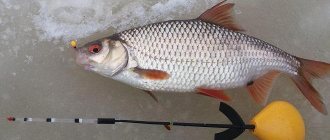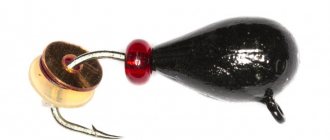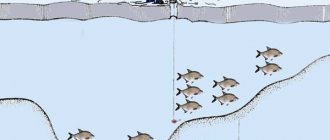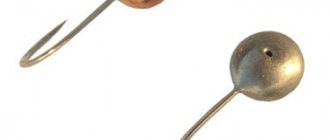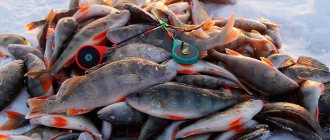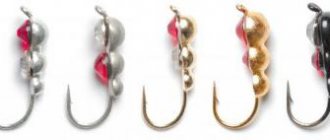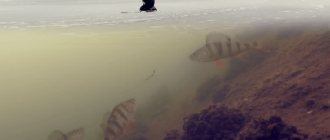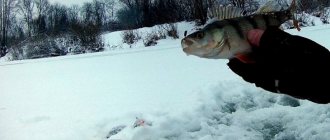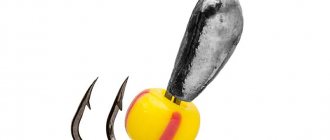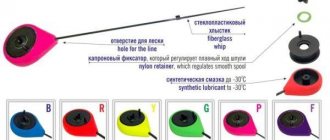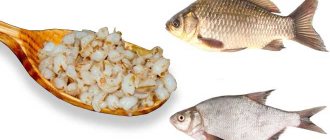One of the parts of winter tackle is a jig. According to Wikipedia, it is a hook soldered into a tin or lead pellet. It takes its name from the mormysh, a small aquatic crustacean.
The jig is an important attribute of a winter fishing rod with a nod; it is an original Russian bait. It appeared in the middle of the last century as a result of an accident. While fishing, one angler’s lead weight slipped onto the very hook and a “mad” bite began. Having comprehended all this, he began to fish with a new bait.
What baits are used for winter fishing?
Winter fishing is varied and even more interesting than summer fishing. Now you can simply go to all places that are inaccessible in summer and drill a hole. Although she has become passive, she remains in the pond and does not stop feeding.
To attract fish in winter, bloodworms are a good bait - these are the larvae of the mosquito. Red worms are visible in the water and are quickly eaten by fish.
Fishing with jigs is the main activity in winter. But it also works in the summer. In recent years, winter fishing with summer gear has become widespread, for example, when fishing vertically from a boat. It also shows good results on bottom gear.
On the first ice, even those that don’t bite in winter, for example, chub, can be caught using a jig and bloodworms.
The most catchy ones:
- Balda Beetle.
- Tula Ant.
- Salmo Drop.
- Salmo Nymph with a loop and phosphor.
- Lucky John (Goat).
- Ball Black.
- Fraction.
- Tula puck.
Other types:
Read: Winter jig cat's eye
Read: 6 varieties of Tula jig
Read: Mormyshka devil
Read: Mormyshka Witch
What is a jig
Its design is very simple. A hook, usually smaller than No. 4, soldered with the shank into a piece of metal. The metal is lead, tin. The shapes of jigs that fishermen have in stock are very diverse. They start from a simple pellet - a weight with a hook, to the most complex shapes and figures, painted in all the colors of the rainbow. The first jigs were similar to baits of animal and plant origin. The names are telling: “bug”, “pellet”, “ant”, “lentil”.
Their sizes also have a wide variety. There are jigs from 2-3 mm to 8-10 mm. Summer jigs are much larger than winter jigs.
Traditionally they are divided into winter and summer.
Winter jigs are used for catching low-active fish. They are small in size, the color of the jig is bright, and they are equipped with different attachments, all this to attract winter fish.
In winter, the following types are used:
- Perch, size from 3 mm to 6 mm. They plant bloodworms and maggots.
- Pike perch, larger in size than all the others. The color is white, the shape is oblong.
- Nozzleless, usually small in size. The role of bait is played by the jig itself without any attachments.
Summer jigs are large in size. This is dictated by the behavior of fish at different times of the year. After all, in summer the bite is much more active than in winter, the bite is more decisive. And the summer color is completely different. For example, to catch crucian carp you need to target dung flies, which are plentiful everywhere in the summer.

The nature of their game depends on the form. Believable movements, similar to underwater inhabitants and “natural” behavior will ensure the catchability of the bait.
Flattened at the bottom and top, it raises a cloud of turbidity at the bottom during navigation. “Droplet” and “pellet” jigs, hitting the bottom, create a cloudy cloud. It is so similar to a living organism that the fish cannot swim past it.
The “Black Widow” deviates along the vertical plane by 5-10 cm, which greatly provokes the perch.
Where there is a jig in the silt, they use tackle similar to this crustacean. Its bottom is ribbed, its top is smooth, and it moves as if sideways.
“Droplet”, “pellet”, “ovinka” create vibrations that are less visible to the fish. Such baits are suitable for fishing in the dead of winter, when delicate play is needed.
A universal jig with a hook No. 2.5-3, sinking to the bottom, enters the silt under its own weight. The hook remains at the top, the fish takes it painlessly.
Hooks on a jig
Fishing with a jig is a very delicate matter. Moreover, its weight itself is 3-5 g. Therefore, there are special requirements for hooks.
The most important condition is their thickness. There is an opinion that the thinner the hook, the better. But this is not for every fish. If you catch perch or pike perch, then yes. But if you are fishing for roach, then for thin lips you need a thicker hook. It is important to find a middle ground here.
The correct hook is the one with the tip parallel to the shank. The length of the forend also sometimes plays an important role in fishing. For example, when catching bream, they try to use a jig with a short shank. And when there is a bite on a bait with a nozzle, they put on a model with a long fore-end.
Also, attention should be paid to the tip of the sting. When fishing, it becomes dull, especially when pulling the bait along the bottom. It is better to use hard, hardened hooks.
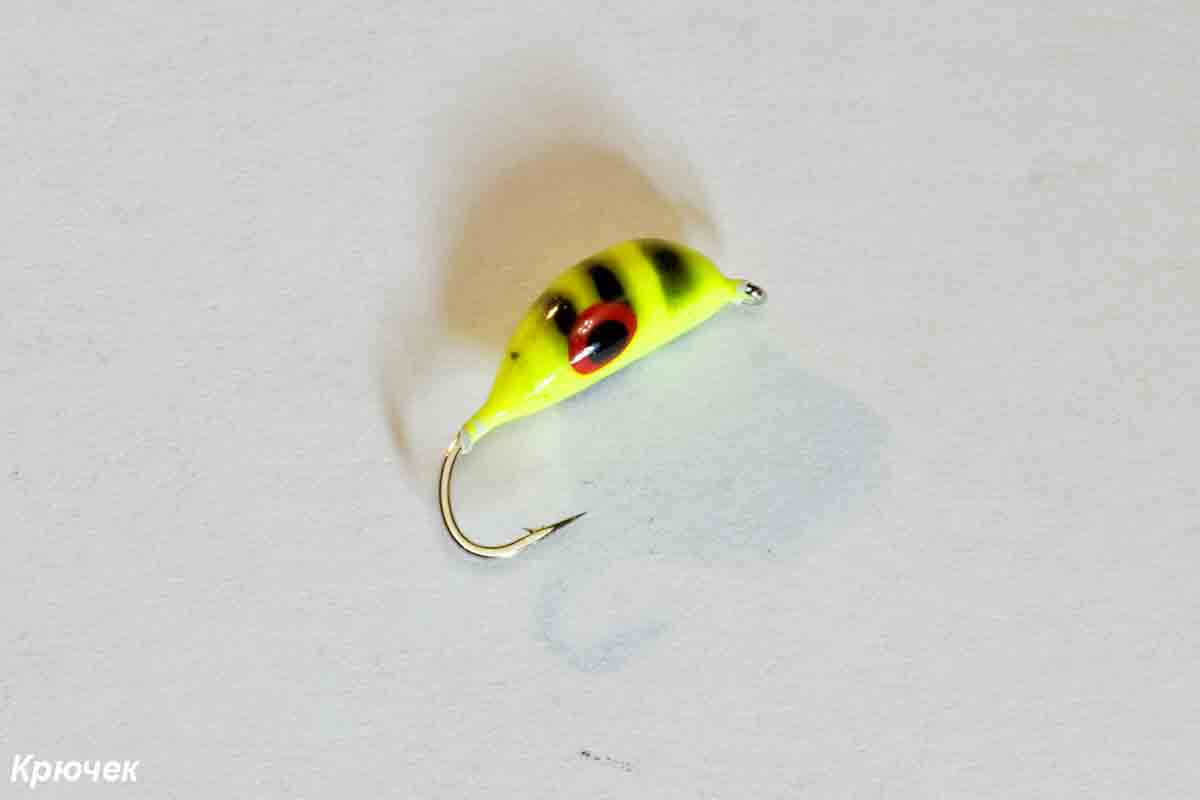
The best material for hooks is steel wire. To increase strength, it is also hardened.
Both large manufacturers and fishermen themselves have plenty of imagination for manufacturing. The most common of these baits is the jig with three hooks - the “devil” has the shape of an inverted drop or grain of wheat. Sometimes they catch bream well with it, putting bloodworms on all three hooks.
Jig weight
Jigs for fishing are divided by weight: light, heavy, super heavy.
Lightweight ones provide a more “subtle” game. Some are shells with solder of tin, various plates of copper and brass. Sometimes such jigs are made of plastic.
Sometimes fishing is effective when tying two jigs on a fishing line: a light one on top, and a heavy one 15-20 cm below.
Light jigs weigh 0.1, 0.5 g, and the largest ones for pike perch can weigh 30-35 g.
Heavy ones are made of lead, from solder containing lead and tin. It is believed that such baits are best used at depth. Also in winter, in severe frost and wind, when the hole is quickly covered with ice, it is difficult to lower a light jig to the required depth. Here she comes with a heavy weight.
Super heavy jigs are suitable for weak bites. They are made from metals heavier than lead. They are poorly processed and therefore damage the fishing line.
Jig color
The fact that the fish distinguishes color can be judged by how the color of the males changes during spawning. And the color of the bait is very important when fishing. It is believed that the fish distinguishes objects at a distance of up to a meter. And such as trout, asp, and grayling see moving objects already at a considerable distance.
Based on experience in fishing, we can distinguish some rules for choosing the color, i.e., choosing the color of the jig:
- In the morning, fish with a shiny bait.
- At noon, put on a dimmer one.
- At depth on a sunny day you can fish with a shiny jig.
- At night, fish do not distinguish colors; their senses of smell and touch work.
For color differences, fishing depth also matters. For example, the color red differs up to 5 meters in depth, then it is perceived as black. And the green color is distinguished by fish up to 15 meters. From here we must assume that at depths greater than 10 meters, the color of the bait does not matter.
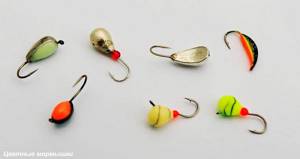
Many fish eat bloodworms, so they associate the color red with food. The golden and silver color makes the bait look like a fry. Green is also common - it looks like algae.
It has been established that when fishing with a jig, roach loves a combination of black, white and orange colors, while perch loves red, yellow and black.
Moths and mothless
The technology for making artificial baits does not stand still. The types of jigs are also varied in their structure.
There are reelless jigs - the same jigs, only used without a hook attachment. And if the bait is almost always a bloodworm in winter, then these are also called mothless ones.
Read: Techniques for winter fishing with a reelless bait
They must accurately imitate underwater animals that fish care about. These are all kinds of goats, devils, witches, jellyfish. Mormyshki bear the names of those living creatures they resemble. Moreover, to improve the bite of the moth, multi-colored threads and beads are tied to its hook.
Advantages of reelless gear:
- The catch rate for large specimens is higher.
- If you skillfully play with such a bait, the biting activity does not decrease.
- No time is wasted on planting bloodworms.
- You can use different ways to play with tackle.
- The fisherman can find exactly his style of fishing.
More catchy reelless models:
- “ant”, which is black in color with white dots;
- “devil” with a size of 4 mm;
- “goat”, which is tied at an angle of 45-50 degrees.
The colors of the cambrics and beads on the jig hooks also matter. Experienced fishermen believe that the best color combination is two whites, or white and black.
Anglers especially like the “devil” for catching bream on the first and last ice. In the first month of freezing, it gives odds to all other models.
Winter jigs
Winter jig fishing is intended for low-active fish. Their size is small, the color is noticeable at a considerable distance. In order to stir up winter fish, a variety of baits are attached to the hooks. Using jigs with attachments is best for beginners. Having lowered such tackle to the bottom, you can patiently wait for a bite.
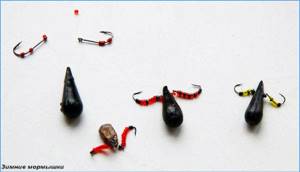
The classic winter baitless tackle for most anglers is the “devil”. Nautilus made a ribbed body shape that is very similar to many larvae and pupae. Many shades of colors are made using electroplating. Tungsten solder was applied to the body of the “devil”.
Advantages of the "devil":
- vertical stable game;
- the appearance really looks like an insect;
- long-term use.
Balda Zhuk is also considered a catchy domestic jig for winter fishing. She looks very much like a living bug. It has two hooks that, when dropped into the water, look like the legs of a beetle. With a sharp swing of the fishing rod, this bait describes a circle in a vertical plane - often it is at this moment that the bite occurs.
“Tula Ant” is made from tungsten billet. Thanks to polishing, it has an attractive play. A cambric is placed in the hole for attaching the fishing line to eliminate chafing of the latter. The Tula Ant is best suited for catching roach.
When fishing in winter, it is easier for novice anglers to master jigs with attachments. They are not so demanding of the game asked of anglers.
Summer jigs
In the summer, when there is enough warmth, light and food in the water, the fish does not refuse to bite jigs.
The differences between summer gear and winter gear come from the behavior of our reservoir inhabitants during the warm period. The fish are active in the summer and the bite happens quickly and decisively. In addition, in the summer there are fish that sleep in the mud in the winter. These are crucian carp and tench, they also bite on the bait placed on the jig.
These summer baits, in addition to being larger in size, also have different colors. For example, a jig for crucian carp is colored to look like a dung fly pupa.
For fishing in the summer, various modifications of the “uralochka”, “devil”, “goat”, and “ant” are used. In muddy water and at depth it is necessary to use copper, brass, with shiny marks.
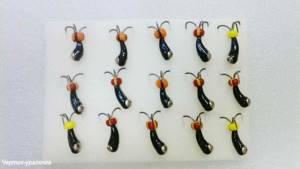
You can also use baitless baits. When fishing without bait, the hook is decorated with beads, black and red thread, a foam ball - it all depends on the angler’s imagination.
Fishing with jigs in the summer is all about finding fish, patience and observation.
Winter jigs
This type of bait occupies a separate place in their qualifications, since the very idea of combining a sinker and a hook was originally intended to activate the bite of passive fish during winter fishing.
Winter jigs are classified according to their weight into the following categories:
- Heavy ones are effective when fishing at significant depths and fast currents, since they tend to sink quite quickly.
- Medium weight - the most popular because they are considered universal, suitable for various fishing conditions.
- Lightweight – used in shallow waters and in the absence of current.
The best jigs for winter fishing are considered to be baits based on tungsten blanks, which have the following properties:
- high immersion speed and stable position even in the current due to the fairly large weight;
- a characteristic game that attracts fish, resulting in increased biting;
- quite small in size, since the material from which they are made has a high density;
- reliability and high strength.
Read more
What flavorings attract crucian carp?
The main types of winter jigs used by ice fishing enthusiasts are lures with bait, which is usually a bloodworm, and a baitless jig - a mothless jig. Using the latter, the fisherman needs to show all the skills and dexterity to make the bait look more appetizing and move more attractive to the fish.
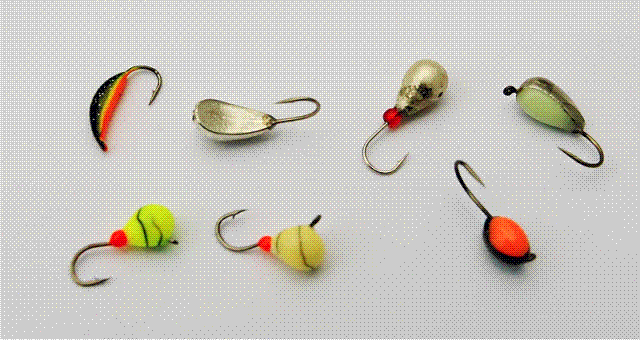
Winter jigs occupy a separate place in their qualifications
Jig fishing technique
In addition to winter fishing with jigs, this bait is used on various fishing equipment. On a float rod, the game is set with the tip of the rod, or the current and wind are used. They also use it to catch fish with a line.
We must not forget that the main thing in fishing with this bait is its performance in the water. The success of the entire fishing depends on the angler’s ability to set the game.
There are many different instructions on working with a jig to attract fish. Each fisherman has his own secrets of this game.
Working with this bait is a creative process. Muddying the silt, dragging it along the bottom, vibrating and freezing in the water column, making it glide, rotating in place - this is an incomplete list of actions during fishing.
Here are some tips for teaching a jig game:
- Smoothly lower it to the bottom, wait 3-4 seconds and just as smoothly raise it 5-7 centimeters above the bottom. Now throw it on the mud and, after a delay, lift it back up. Thanks to this, the turbidity is understood and sound waves are created.
- Lower it to the bottom and stir it. This technique is good in clear water.
- Lower it to the bottom and pull it along the bottom, stopping from time to time.
When playing, you need to observe those moments of the game when the fish bit. When there is no bite at all, you need to try to move the bait sharply and throw it to the bottom.
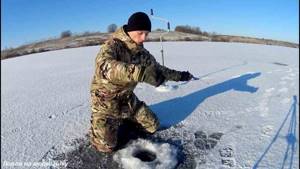
Another good thing about a jig is that you can attach a different set of attachments to it. Almost all anglers bait only bloodworms. But maggots and various larvae are also suitable.
Read: Seven ways to attach bloodworms to a jig in winter
They also use “sandwiches” - several baits are simultaneously placed on a hook. The most widely used are bloodworms and maggots.
A winter jig with a nod can be especially successful when fishing on the first and last ice. In these cases, the fish behaves actively and bait is not needed.
Many jig makers use a “devil” type product. This is an effective bait. 2-3 cambrics of different colors are put on its hook. Edible baits are not attached, because the “devil” is baitless. Moreover, it is believed that catching an empty jig is the highest level of fishing skill.
Types of jigs
An experienced fisherman keeps different types of jigs in a box.
Summer and winter baits
Summer and winter baits differ in weight. In summer, the upper layers of the reservoir are filled with fry, which attack any bait, which means they do not allow it to reach the bottom, where large fish swim. To protect the bait, summer jigs are made heavier than winter models.
In summer, the water in the reservoir is more cloudy, so the color of the jig should be brighter.
The winter jig is smaller in size than the summer bait. This is necessary so that the bait looks more believable in clear water.
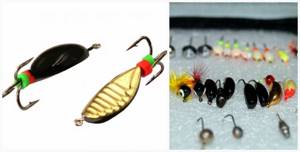
Moths and mothless
Bloodworm is the most catchy bait. This bait is very delicate, which means it is not difficult for the fish to knock it off the hook. Experienced fishermen start fishing with reelless reels and then switch to baits.
Mothless fish resemble insects that are part of the fish’s diet, so it bites without fear. For better attractiveness, the bait is decorated with shiny threads. In some cases, sprays with a special scent are used. Moths with an animal bait increase the chance of a bite, since the fish have a well-developed sense of smell.
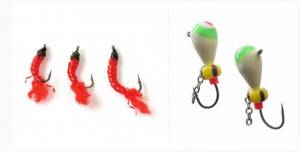
Form
The behavior of the bait depends on the shape if there is a current or standing water. A jig with a teardrop shape when inserted imitates an insect caught in the water. This bait is usually attacked by perch and ide.
The flattened jig resembles a butterfly. When wiring near the bottom, a cloudy cloud is created. It attracts curious fish.

Weight
Since reservoirs come in different depths and with different current intensities, baits are needed that will have different weights. They are made light, medium weight and heavy.
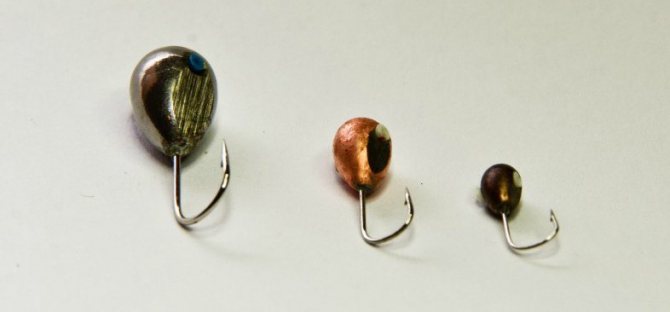
Cargo material
To make the bait sink faster to the set depth, it is made heavier. Tin, lead, and tungsten are used as weighting materials.

Color
To make the jig attractive for winter fishing, it is painted in different colors. Due to refraction in the water column, the color of the bait changes. At great depths, red and yellow colors are clearly distinguishable. Each type of fish has colors associated with food. For example, roaches have black, white and orange colors. Predatory fish are attracted to black, red and yellow colors.
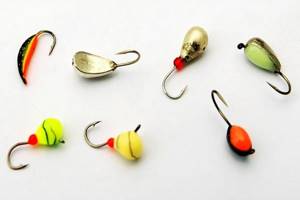
Hooks
Jigs use from one to three hooks. Thin hooks have advantages, but they cut the fish’s lips and the catch is lost. In a standard jig, the forearm and sting form one plane, but a hook with a bent sting is needed for predatory fish.
A jig with a nozzle should have a long fore-end to better hold the bloodworm.

How to tie jigs
The pattern of tying to the line can have some effect on the fish biting. There are indicators that are worth paying attention to:
- the stronger the knot, the greater the load the entire equipment can withstand;
- the smaller the knot in visual terms, the more invisible it is to the fish;
- an incorrectly tied knot limits the play of the bait.
Correct tying of fishing line to jig:
- pull the end of the fishing line into the hole;
- tie the fishing line in a knot;
- pull the loop onto the fore-end towards the end of the hook;
- trim off all excess.
Many models have an eyelet in the upper part for attaching with a fishing line. For such people, the most reliable knot will be a simple noose.
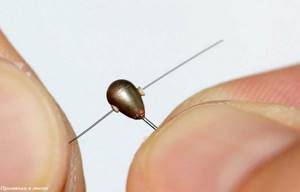
When tying a tungsten jig, you must remember that hard metal can damage the fishing line and this will lead to breakage. You can select a cambric in the hole according to its diameter and stretch the fishing line into it. Or take a braided cord and make a loop on the jig. Tie the fishing line to this loop.
It is important that the line does not touch any sharp edges. It is better to choose lures with rings, they are easier to tie.
Catchable jigs
When winter jig fishing is expected, you should know about the best baits so as not to sit on the pond in vain.
Experienced fishermen advise paying attention to the following specimens:
"Ant 3.0/2 86601 – 0.2"
This element is manufactured by a domestic manufacturer. The weight of the part is only 0.28 grams. As for the hook, it is number sixteen. Yellow beads and a silicone tube are the distinctive features of this jig.
"Lucky John 20-S"
The presented element is a “devil”, which has number eighteen hooks, and the weight of the jig is 0.25 grams. The product is manufactured in Latvia.
"Lucky John LJ13050-139"
This bait is made of tungsten, its weight is 1.3 grams, and its diameter is 5 mm. The presented product is famous for its durability and strength, despite the fact that it has an affordable price.
"Lumicon Female Ant d.3.0"
A jig of this type is large and fully corresponds to the parameters of an ant. The element is usually sold in sets, each containing 10 pieces.
Making jigs with your own hands
The nature of a fisherman is such that he is always looking for something new, his own. With a large number of artificial baits in the trade, there are craftsmen who make these products at a high level.
A fisherman who has some skills in working with plumbing tools can make it himself. There are a lot of ways to make these baits, here are some of them:
- Sawing is the easiest way. Various figures are cut out of pieces of copper, stainless steel, and bronze. The hooks are soldered and finishing is carried out.
- Soldering is a more complex method; here you need to know how to solder metal. Also, parts are soldered from pieces of different tin, hooks are soldered, and protected.
- Casting - only tin and lead are used. Casting begins with making a mold. It is made of wood, plaster, aluminum. The molten metal is poured into molds, and after cooling, the workpieces are cleaned.
A good result is obtained by painting jigs purchased or made yourself. They are painted with nitro varnishes, for example, nail polish. Perch really likes the pearly color.
Industrial products sometimes have shortcomings that need to be eliminated. It’s unpleasant when a seemingly good jig has a bad hook welded on it. Using a soldering iron, it must be replaced with a better one.
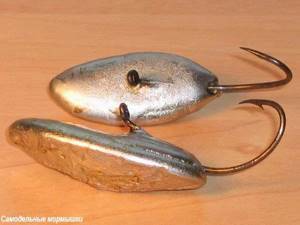
It is impossible to replace the hook in a lead jig; you need to pay attention to this when purchasing. The hook should be commensurate with the body of the bait itself.
Advantages and disadvantages of homemade products
Why do fishermen make their homemade products? Doing everything himself, the fisherman selects its parameters for himself and his fishing conditions. Not everything from the store will appeal to an avid jig fisherman. The only disadvantage of homemade baits is the lack of qualifications of the manufacturer.
Read: DIY jigs
Read: Catchable jigs for smelt: manufacturing instructions
Read: Banana jig: when it’s effective, how to catch it, how to make it yourself
Read: Making a nail cube jig with your own hands
Read: Step-by-step instructions for making phosphorus jigs at home
Fishing with a jig: tips and secrets of winter fishing
The advantage of winter fishing is that fish are available in all parts of the reservoir. The main fishing tool at this time is a winter fishing rod with a jig. It is simple, even homemade, and is cheap in the store. You just have to learn how to fish with it.
If we exclude all the preparatory work, then the main point is the bite. Any bite requires an immediate hook. Novice fishermen usually do not notice this moment or are late with it.
If the angler is not sure that there was a bite, then you just need to stop the game. When there is a pause, the bite is more noticeable.

Possible process of biting on a winter fishing rod with a jig:
- the nod went down - a perch bite;
- the nod went up - a bite of bream, roach;
- the nod froze - this is how it usually bites in the middle of winter.
The peculiarity of fishing is such that you must constantly play at a fast pace and with a small amplitude.
There are still plenty of fishing opportunities with this tackle and they are far from being exhausted.
Nozzle jigs
Any model of this type of jig is characterized by a basic property - their use does not involve the use of natural bait, and their attractiveness is ensured only by the unique nature of the bait’s play in the water.
Among the reelless jigs, the most popular types are:
- Uralka is popular among those who like to hunt perch. Fishing tackle stores usually offer a large selection of this type of reelless hook, differing from each other in size, color, and the presence of beads of different shades at the base of the hook;
- devil is the most catchy bait for pike perch, equipped with three or even four hooks;
- goat is a type of devil, although many distinguish it as a separate independent species. This jig is made primarily from copper or brass. The number of hooks a goat has is less than that of a devil, and in order to ensure effective fishing with it, you need to know the intricacies of placing the bait;
- boat - designed for catching peaceful fish, therefore it requires active wiring. Its colors are quite diverse, and the design is improved with additional elements that attract the inhabitants of the aquatic depths;
- ant is a bait with a body divided into segments. Its very name indicates the similarity of the jig to a living insect, and the nature of the movements with a small amplitude exactly imitate the behavior of an ant that has fallen into the water. All baits of this type have approximately the same weight - 0.3 g, although it can be increased by adding beads to make it heavier;
- donkey - a bait similar to a quarter of a coffee bean, mostly black. It is considered almost universal, since it has shown itself well in and without current.
Read more
How to catch bream with lard?
But no matter which of the listed types of baitless jigs the fisherman chooses, he will be able to determine the catchability of the bait only by testing in practice, under certain conditions, fishing on a specific body of water.
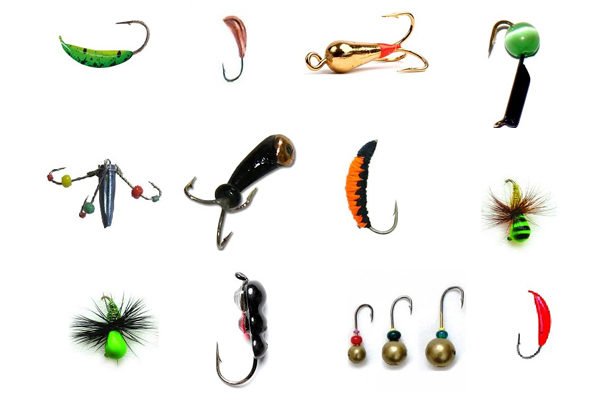
Nozzle jigs
